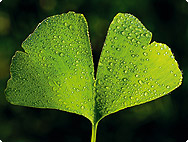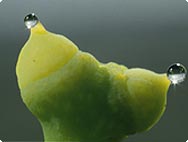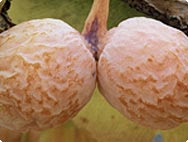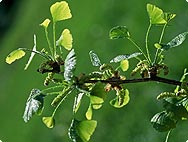
Ginkgo biloba L. ssp..collina
Ginkgo Tree

History
The Ginkgo tree is the only
surviving representative of the ginkgo genus that flourished at around
the time of the dinosaurs. For this reason it is also known as a
‘living fossil’. 150 million years ago, ginkgoes were to be found all
over Europe. They disappeared from Europe during the Ice Age. The
only type of Ginkgo to endure was Ginkgo biloba, which survived in
south eastern China, where it was cultivated and worshipped as the
‘tree of knowledge’. In traditional Chinese medicine, Ginkgo seeds were
considered a highly valuable remedy for tuberculosis, on account of
their strong antibiotic properties. Ginkgo was also administered as an
expectorant, a sedative, digestive and anthelminthic (for expelling
worms). The tree was taken from China and introduced to Korea and Japan
where it was often planted in the vicinity of temples.
In 1712 the Ginkgo tree was described by the German doctor and
naturalist, Engelbert Kämpfer, who studied the tree during a two-year
sojourn in Japan. The first Ginkgo tree was planted in Europe around
1730 at the botanical gardens in Utrecht. The Ginkgo tree has been
immensely popular in Europe ever since. The famous German poet,
Wolfgang von Goethe, described the plant's fascinating two-lobed leaves
in a poem that appeared in his anthology West-Eastern Divanin 1815:
Ginkgo biloba
This leaf from a tree in the East,
Has been given to my garden.
It reveals a certain secret,
Which pleases me and thoughtful people.
Does it represent
One living creature
Which has divided itself?
Or are these Two, which have decided,
That they should be as One?
To reply to such a Question,
I found the right answer:
Do you notice in my songs and verses
That I am One and Two?
Today, the Ginkgo
tree can be found all over the world and is prized just as much for its
beauty as for its resistance to air pollution and insects.
Unfortunately, the male trees are cultivated more often than the
female, since the mature seeds of the female trees emit a rather
unpleasant odour.
The Ginkgo tree was given its botanical name Ginkgo biloba by the
botanist Carl von Linné in 1771. His choice was based on Engelbert
Kämpfer's name for the tree. The Japanese name for the tree is ICHÔ
(pronounced Ichoo) or ICHÔ NO KI (Ichô tree) and the valuable nuts are
known as GINNAN. The character for both the tree as well as the nuts is
written thus:
The first sign is pronounced GIN and means ‘silver’. It is composed of
the character for ‘gold, yellow, metal’ and ‘good’. The second
character comprises the characters for ‘tree’ and ‘mouth’ and is
pronounced ANZU, meaning ‘apricot’. Ginkgo nuts are used in various
traditional Japanese dishes. Roasted and lightly salted, they have a
mild, slightly bitter aroma and make an excellent accompaniment to sake
or beer.

Botanical characteristics
The Ginkgo tree grows to a height of 30 or 40 metres; it is dioecious and its trunk has a circumference of up to four metres. Ginkgo can live for up to 4,000 years; , the first flowers appear when it is roughly 25 years old and it can remain fertile for over one thousand years. The bark is pale grey and roughly grooved. The leaves are presented either alternately on long shoots or in bunches on shorter shoots. They have a characteristic fan-shape and are either lobed or unlobed, depending on the age of the tree. The venation of the Ginkgo tree runs parallel, a reminder that it was once related to the conifer at a much earlier stage in its development. In the autumn the leaves turn a golden yellow colour and fall to the ground. The female flowers comprise a short stem with two ovules. They are arranged individually in leaf axils or in groups on small shoots. The somewhat larger male blossoms are similar to catkins and are also arranged on small shoots. Fertilisation occurs by means of mobile sperm cells around five months after pollination. The mature seeds (often incorrectly described as fruits) develop into yellow balls of approximately 3cm in diameter. The hard, fleshy outer skin gives off an unpleasant odour not unlike butyric acid. This skin is washed or rubbed off prior to use and the seeds are removed from the hard shell. The tree flowers from April to May.

Habitat
There are large areas of naturally occurring Ginkgo in China, Japan and Korea; it is also cultivated in plantations in Europe.

Preparation
A.Vogel/Bioforce produces a mother tincture from the fresh leaves of Ginkgo trees.
A.Vogel Blog – Natural and Healthy
Inspiration for a healthy life!
HERBAMARE SOUP-ER SOUPS!
DOWNLOAD YOUR FREE RECIPE BOOKLET!
8 healthy, hearty and delicious homemade soups.
Supporting a healthier happier you
“Nature is just about the best thing we’ve got!“
Alfred Vogel's guide to leading a healthy and happy life
Healthy & nutritious dinner ideas
Get new recipes in your inbox every month. Sign up now